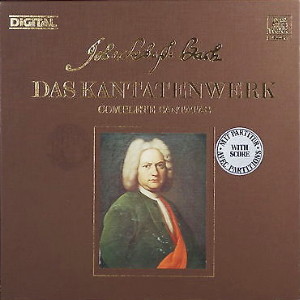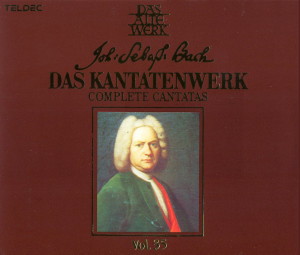 |
|
2 LPs
- 6.35653 EX - (p) 1984
|
 |
| 2 CDs -
242-630-2 ZL - (c) 1989 |
|
| DAS KANTATENWERK - Volume 35 |
|
|
|
|
|
|
|
| Johann Sebastian
BACH (1685-1750) |
Kantate
"Lobe den Herrn, meine Seele" II,
BWV 143
|
|
13' 14" |
|
|
Kantate
am Feste der Beschneidung Christi
(Neujahr) (Festo circumcisionis Christi)
|
|
|
|
|
Text:
unbekannt; I. Psalm 146; 3. Psalm 146,5;
5. Psalm 146,10; 2. und 7. Jakob Ebert
1601
|
|
|
|
|
Solo:
Sopran, Tenor, Baß - Chor; Corno da caccia
I, II, III, Timpani; Fagotto; Streicher;
B.c. (Violoncello, Violone, Organo)
|
|
|
|
|
- 1.
Chor: "Lobe den Herren, meine Seele"
|
1' 14" |
|
B1 |
|
- 2.
Choralbearbeitung (Soprano): "Du
Friedefürst, Herr Jesu Christ" |
2' 14" |
|
B2 |
|
- 3.
Recitativo (Tenore): "Wohl dem, des Hülfe
der Gott Jakob ist" |
0' 18" |
|
B3 |
|
- 4.
Aria (Tenore): "Tausendfaches Unglück
Schrecken" |
2' 53" |
|
B4 |
|
- 5.
Aria (Basso): "Der Herr ist König
ewigkeit" |
1' 14" |
|
B5 |
|
- 6.
Aria (Tenore): "Jesu, Retter deiner Herde" |
2' 19" |
|
B6 |
|
- 7.
Choral: "Gedenk, Herr Jesu, an dein Amt" |
2' 13" |
|
B7 |
|
|
|
|
|
|
Kantate
"Nimm, was dein ist, und gehe hin",
BWV 144 |
|
13' 12" |
|
|
Kantate
am Sonntag Septuagesimae (Dominica
Septuagesimae) |
|
|
|
|
Text:
unbekannt (Picander?); 1. Matthäus 20,14;
3. Samuel Rodigast 1674; 6. Markgraf
Albrecht von Brandenburg 1547 |
|
|
|
|
Solo:
Sopran, Alt, Tenor - Chor; Oboe d'amore;
Streicher; B.c. (Violoncello, Violone,
Organo) |
|
|
|
|
- 1.
Chor: "Nimm, was dein ist, und gehe hin" |
2' 02" |
|
B8 |
|
- 2.
Aria (Alto): "Murre nicht, lieber Christ" |
5' 00" |
|
B9 |
|
- 3.
Choral: "Was Gott tut, das ist wohlgetan" |
1' 45" |
|
B10 |
|
- 4.
Recitativo (Tenore): "Wo die Genügsamkeit
regiert" |
0' 54" |
|
B11 |
|
- 5.
Aria (Soprano): "Genügsamkeit ist ein
Schatz in diesem Leben" |
3' 06" |
|
B12 |
|
- 6.
Choral: "Was mein Gott will, das g' scheh
allzeit" |
1' 08" |
|
B13 |
|
|
|
|
|
Roger
Cericius (Solist des Knabenchores
Hannover), Sopran (BWV 143)
Ansgar
Pfeiffer (Solist des Knabenchores
Hannover), Sopran
(BWV 144)
Paul Esswood, Alto (BWV 144)
Kurt Equiluz, Tenor
Max van Egmond, Baß (BWV 143)
Knabenchor Hannover |
Heinz Hennig, Leitung
Collegium Vocale Gent | Philippe
Herreweghe, Leitung
Das verstärkte LEONHARDT-CONSORT mit
Originalinstrumenten
- Ab Koster, Bob Stoel, Knut Hasselmann (BWV
143), Corno da caccia
- Nick Woud, Timpani
- Ku Ebbinge, Oboe d'amore
- Marie Leonhardt, Lucy van
Dael, Alda Stuurop, Antoinette van den
Hombergh, Marcel Destubé, Violinen
- Staas Swiestra, Ruth Hesseling, Viola
- Frans R. Berkhout, Fagotto
- Wouter Möller, Lindewij Schijfes (BWV
143,1,4,5,6,7; 144,1,2,3,6), Violoncello
- Anthony Woodrow, Violone
- Gustav Leonhardt (BWV 143,2,3; 144,4), Bob
van Asperen, Orgel
Gustav Leonhardt, Gesamtleitung
|
|
|
|
|
Luogo
e data di registrazione |
|
(Luogo e data di
registrazione non indicati)
|
|
|
Registrazione: live
/ studio |
|
studio |
|
|
Producer |
|
Wolf Erichson
|
|
|
Prima Edizione LP |
|
Teldec "Das Alte
Werk" | 6.35653 EX | 2 LPs -
durata 55' 21" - 47' 40" | (p)
1984 | DIGITAL DMM
|
|
|
Edizione CD |
|
Teldec Classics |
LC 6706 | 242 630-2 ZL | 2 CDs -
durata 55' 21" - 47' 40" | (c)
1989 | DDD |
|
|
Cover
|
|
Johann Sebastian
Nach, einige Jahre vor seiner
Ernennung zum Kantor in Leipzig.
Gemälde con JJ. Ihle (1720) Bach
Museum Eisenach.
|
|
|
Note |
|
In questo volume sono
presenti anche La Cantate BWV 140,
BWV 145 e BWV 146 a cura del
Concentus Musicus Wien diretto da
Nikolaus Harnoncourt.
|
|
|
|
|
INTRODUCTION
by Gerhard Schuhmacher
The occasion and date of
composition and whether it
was performed during Bach’s
lifetime of »Lobe den
Herrn, meine Seele« (BWV
143) are still not at
all clear. The claim by
Spitta and Schering that it
was performed on New Year’s
Day 1735 is contradicted by
evidence that the fourth
cantata of the Christmas
Oratorio was sung on that
occasion. In its conciseness
the cantata is related
stylistically to the motet
(Nos. 1 and 7), to the older
aria (Nos. 4 and 5) and to
the sacred concerto (Nos. 2
and 4). A striking feature
are the three horns, to
which he added timpani in
the fifth movement. Judging
by the style this work
probably falls between BWV
71, the cantata written for
the occasion of the election
of a new town council in
Mühlhausen (1708) and the
change in the style of his
cantatas in 1714; since it
is scored for horns the date
of composition is probably
close to that of the Hunting
Cantata BWV 208 (1713). On
all other occasions Bach
symbolised the reign of
Jesus the King by three
trumpet parts and timpani,
trumpets being the privilege
of rulers. The continuo
writing and this early use
of horns are strong
arguments in favour of
Bach’s authorship.
»Nimm, was dein ist, und
gehe hin« (BWV 144),
written for 6th February
1724, is introverted in
character. The opening
chorus is a strict fugue, in
which the subject is sung in
large note values to the
words of the title (»Take
what is thine and go hence),
the last words (»gehe hin«)
being treated as a
sequential counterpoint and
further elaborated. In the
alto aria »Murre nicht,
lieber Christ« (»Do not
complain, dear Christian«)
the complaints are depicted
by the use of the low
register, thereby
disregarding the negation
implicit in the text. This
is maintained throughout the
contrapuntal variations of
the aria: »Murre nicht« is
always set in low notes,
»lieber Christ« in high
notes. After a simple
chorale verse »Was Gott tut,
das ist wohlgetan« and a
preparatory recitative, the
great soprano aria with oboe
d’amore and continuo
»Geniigsamkeit ist ein
Schatz in diesem Leben«
(»Moderation is a treasure
in this life«), full of
expansive gestures and
coloratura, provides the
opportunity for Bach to give
free reign to his certain
faith. The seeming
contradiction is cancelled
out by the music: although
the scoring is »moderate«,
there is ample scope for
development. In place of the
customary da capo there is a
freely varied repetition,
variations providing a
richer style than a mere
mechanical reprise.
|
  |
|
|